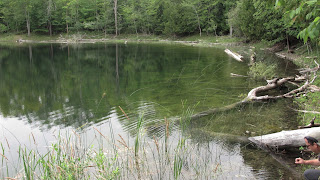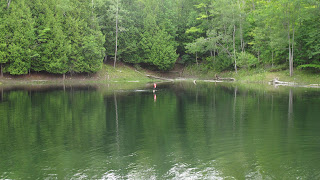ROCKPORT AND PRESQUE ISLE INLAND SINKHOLES
July 20, 2015
Back in the Rockport State Recreational Area forest lies over 12 relatively un-explored Devonian Era sinkhole karst features. These sinkholes are filled with water and might contain clues as to what has occurred during the last Holocene as well as the possibility of some interesting man-made and natural artifacts that may be preserved at the bottom of these sinks. Furthermore, understanding the geological nature of these sinkholes may also shine some more light on current theories or inspire a different theory with clues that these sinkholes might hold secret at the bottom including the possibility of dormant cave passage.
Previous diver
observations and aerial photos have pointed out a ledge of sorts leading to an unknown place in the sinkhole, a thick layer of suspended material, and the understanding of the geological makeup of the regional area have left questions as to what is at the bottom and how these karst features might have been formed.
Although these sinkholes are inspiring to consider that submerged passage might exist, I question if the passage has not already been filled by glacial till and other deposits from the last Holocene or that the strata is impermiable for water to flow faster than a drip at a time. The Traverse group, and the Rockport Quarry give me a suspicion that there is a possibility of some type of dormant submerged passage yet with the veins of gypsum and other minerals which are thought to be in the Detroit group bedrock, the dissolution and the evacuation of these minerals are believed to have created underground karst cavities where limestone and shale collapse onto itself from the surface and a subsequently creating a tube of impassable breakdown rubble leading down vertically like filling a vertical pipe with rocks leaving a circular shape at its surface…or is impassable?
A confirmation of this phenomenon with certified cave divers will strengthen this belief among geologists and confirm what is actually at the bottom of these sinkholes. No Doubt, this will bring some closure to the mystery of what is at the bottom of the big sink and other sinks in the area, but there is a optimistic possibility that other artifacts and materials can be realized for further study including human made artifacts.
Finally, researching these sinkholes might also be able to help the community understand what is happening underground which might be able to help predict and understand future sinkhole openings and watershed hydrology.
For over 150 years now, Thunder Bay and Presque Isle have had an active shipping history with mariners finding the regional area rather difficult to navigate which has led to some of the most historic and well preserved shipwrecks on the bottom of Lake Huron. The Thunder Bay National Marine Sanctuary and NOAA have teamed up to preserve these shipwrecks which has become quite the location to dive and one of the best diving destinations on the planet to visit in-tact shipwrecks like the shipwreck of the Cornelia Windiate and the shipwreck of the Defiance. To learn more about shipwreck diving reach out to thunder bay scuba at www.tbscuba.com and ask to speak to Joe about the shipwreck diving opportunities. Just off into the woods of Rockport is an old quarry that has been shut down for years but has a lot of fossil artifacts that are embedded into the limestone. One can find corrals, sponges, and isopod fossils in the limestone. Some of these fossils are abundant as they lay scattered on the quarry floor.
GEOLOGY
DIVE PROJECT PLAN:
The main focal point of this project will be the “Big Sink”. Based on my previous visit to these sinkholes the past year and from our research we conducted with expert judgment, the Big Sink will be the primary focus and camp 1 will be set up on the flat top surface near the trail.
Separate dive operations will be planned and prepared for at camp 1.
Our Primary dive will be conducted in the Big Sink and with the first dive to be an initial high level overview exploration of the bottom of the sinkhole itself. A possible survey might be conducted but at the time of this observation dive, we decided to observe the sink.
A dive flag will be place at the focus point on the surface of the big sink where the 90ft water depth was indicated and where the deepest point of the sink is thought to be. Another dive flag will be considered at the cliff ledge karst feature which is at an estimated depth of 40ft.
The dive group will decide before the dive to either tie off a reel or make their initial descent into the sink or utilize attachment points on the anchor and run reels from the anchor at depth. Divers will pay attention to the tree obstruction and the thick “haze layer” at an unknown depth.
The bottom of the sink has been reported to be a rock bottom so from the anchor point at depth, divers will proceed with a search that will be pre-determined at the pre dive plan and will proceed to follow the search protocol until obstructions exceed the divers risk threshold, or the sink has been initially “groomed”.
If a passage has been discovered, the diver will deploy a surface buoy to mark the location of the cave passage. Diver can than proceed to push the passage.
We initially had a dynamic operation planned with multiple camps and cave divers but we minimized the efforts to just three people, one on the surface, one conductin a primary search and another for overview and obvservation. Certified Cave and Technical Cave Divers, Adam Haydock, Chris Parks, and Mike Apke brought diving gear to the big sink in the forest to perform the initial checkout dive. I stayed top side while Mike and Chris prepared for low visibility, tree obstructions, and the possibility of discovering new cave passage among other anomalies underwater.
The divers entered the water and began the initial search to report back what they found at the bottom while I provided surface support and observed the sink from the top side. Around the sink I noticed small fissure cracks that traced around the sink leading me to believe that the rock is slowly sliding down into the sink itself from ice, snowmelt, and rain fall.
Around the sink the divers reported that the visibility was around 20ft. from 0ft. of depth at the surface to around 25-40ft. of depth. Two types of plant growth at the bottom and reports of bass, possibly small mouth bass were reported swimming about.
The composition appeared to be a silty mud composition which was consistent around the outer circumference of the karst feature. The bottom terrain was trending downward on a 25 to a 35 degree angle until it reached a vertical rock wall in the middle of the sink.
A 90 degree vertical wall surrounding the inner sink contour dropped down to a depth from 40ft to 59ft. The depth of 59 feet was the max depth that the divers reported in the “Big Sink” and at this depth the water became significantly colder. The visibility diminished form 25ft down to 3-5ft. There was a organic sediment cloud inside this inner sink that created the diminished visibility which is assumed to have been kept in place by the vertical limestone wall.
At the bottom of the sink at max depth, Chris reported that there was a layer of thick silt which was compacted and a continued push to go deeper into this silt was impossible.
There were a number of trees that were reported to be upright with the tops of the trees pointing back up the slope which gives more evidence to the land sliding into the sink and the trees merely falling to the side and pointing back up towards the slope as they continued to slide down to the bottom of the sink.
I vectored the divers to explore triangular sections of the middle of the sink and they “groomed the garden” by going back and forth up and down the sink which only rendered similar results of a trending slope to a vertical face and the same reported depths, temperature, and bottom composition. There were no passages to be found which is what I suspected.
This all goes with the theory that the sinkholes are more like” flooded quarries “ that were plugged by a composition which might include some glacial till from the last Holocene and other material that may be sliding into the sink. Rain and ground water rises, collects and keeps itself in these karst kettles which might preserve the cold water and the slowly decaying organic material at the bottom which is surrounded by a tubular limestone wall. The brittle limestone and shale layer appears to not be sufficient enough to sustain passage like St. Genevieve limestone that can be found further south in Indiana.
Based on the research I have done and the expert judgment I have received, my conclusion is that these sinkholes are subsurface tubular-like rubble collapses where the gypsum and sulfate layers in the Detroit Group strata have dissolved away therefore creating a set of chambers that have collapsed on themselves forcing the limestone and shale layers to subsequently collapse from the surface. There are around 13 of these sink holes in the area and this one was the most accessible given the time that we had to dive. Mike mentioned that he could smell a faint scent of sulfur on him but we could not confirm or smell any sulfur odor.
This all goes with the theory that the sinkholes are more like” flooded quarries “ that were plugged by a composition which might include some glacial till from the last Holocene and other material that may be sliding into the sink. Rain and ground water rises, collects and keeps itself in these karst kettles which might preserve the cold water and the slowly decaying organic material at the bottom which is surrounded by a tubular limestone wall. The brittle limestone and shale layer appears to not be sufficient enough to sustain passage like St. Genevieve limestone that can be found further south in Indiana.
Based on the research I have done and the expert judgment I have received, my conclusion is that these sinkholes are subsurface tubular-like rubble collapses where the gypsum and sulfate layers in the Detroit Group strata have dissolved away therefore creating a set of chambers that have collapsed on themselves forcing the limestone and shale layers to subsequently collapse from the surface. There are around 13 of these sink holes in the area and this one was the most accessible given the time that we had to dive. Mike mentioned that he could smell a faint scent of sulfur on him but we could not confirm or smell any sulfur odor.
The sinkholes out in lake Huron are fascinating in itself as we have been out to visit them on multiple occasions and had a change to observe the vents that spring out sulfur, dissolved gypsum, and other sulfide materials. This cold spring water it thought to be coming form the Detroit group almost 800 ft. under ground and appears to trend into the Rockport preserve where these inland sinkholes are located. The underwater springs have a layer of bright yellow sulfur that is crystal clear which creates a chemocline that fish dare not pass.
There are also cyanobacteria mats of extremophile organisms that thrive off of these chemicals and gives clues to not only what is happening underground, but what has happened during the Devonian era and even with a possible link to how extra terrestrial organism might exist on other planets.
Here is more information regarding the middle island sinkholes: http://adamhaydock.blogspot.com/2014/06/middle-island-underwater-sink-resurgence.html





















0 comments